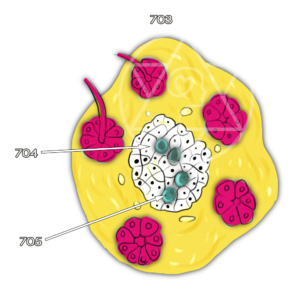Islets of Langerhans
Anatomy
In the pancreas, besides the exocrine parenchyma producing digestive juice, there are islets of endocrine hormone-producing cells all over the surface of the organ. The hormones synthesized in these islets of Langerhans are mainly insulin and glucagon for energy management: the distribution and storage of glucose.
Glucose (sugar) is the nutrient used everywhere in the body for power generation. It is soluble in water and thereby transferred from the intestines to the bloodstream by diffusion. The blood sends it to the organs. All cells acquire energy in the form of adenosine triphosphate (ATP) in their mitochondria via the respiratory chain, and even the heat generated in the reaction is used for maintenance of the body temperature.
Nerve cells are supplied directly and exclusively by glucose. Therefore, the organism must keep the concentration of glucose in the bloodstream constant.
- Insulin is needed to transport glucose into muscle and fatty tissues, and to transform the unused energy into a storable form, glycogen. The liver is another store for great amounts of glycogen.
Insulin also supports fat storage as body fat and suppresses degradation of fat (lipolysis). Insulin is released after each meal.
- Glucagon is the partner and antagonist of insulin: it is needed to transform glycogen into glucose and to transfer it into the bloodstream. Glucagon also supports the degradation of fat.
The blood sugar level feeds back into the system to release or suppress both hormones.
META-Organ Tissues
Alpha Islet Cells (CC -/+) Stress (resistance, avoiding confrontation, or disgust): Reduction of glucagon production
Beta Islet Cells (CC -/+) Stress (resistance, avoiding confrontation, or disgust): Reduction of insulin production







